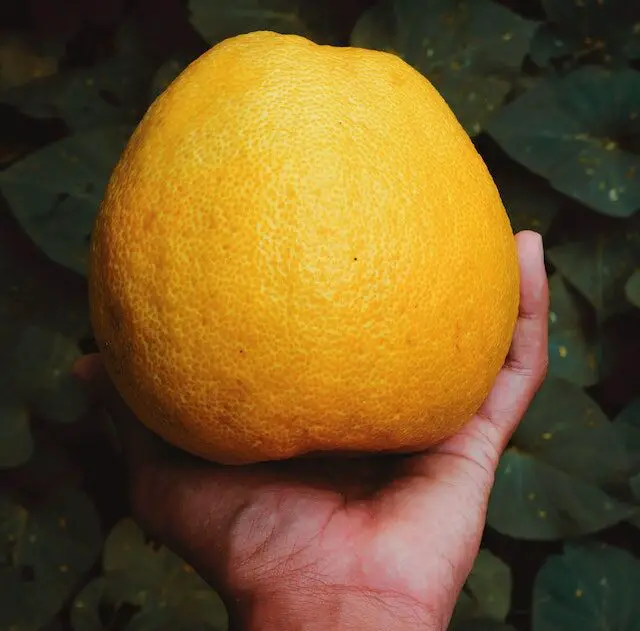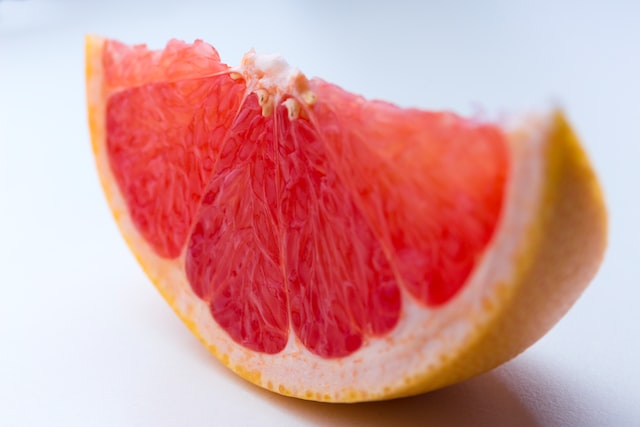Pomelo and grapefruit are both citrus fruits with a similar appearance. The most notable difference is their sweetness; pomelos tend to be much sweeter than grapefruits. Additionally, pomelos also have thicker skins and less acidic juice than grapefruits.
What is pomelo?
(Photo by Sameera Madusanka)

Pomelo is a citrus fruit that is closely related to grapefruit. It is thought to be a cross between a grapefruit and a sweet orange. Pomelo is the largest member of the citrus family, and can grow to be up to 18 inches in diameter. The skin of a pomelo is thick and can range in color from green to pale yellow. The flesh of the pomelo is pink or red, and is very juicy. The flavor of the pomelo is sweeter than that of a grapefruit, with less acidity.
What is grapefruit?
(Photo by Isaac Quesada on Unsplash )

Grapefruit is a citrus fruit that is thought to have originated in Barbados. The grapefruit tree is believed to be a hybrid of the sweet orange and the pummelo, and was first documented in 1750. The grapefruit is a large citrus fruit that can range in color from white to pink to red. The flesh of the grapefruit is tart and juicy, and can be used in a variety of dishes.
The grapefruit is a popular breakfast fruit, as it is high in vitamins and fiber. It can also be used in juices, cocktails, and desserts. Grapefruits are an excellent source of Vitamin C, and they also contain Vitamin A, potassium, and magnesium.
What is the difference between pomelo and grapefruit?
Pomelo and grapefruit are two similar citrus fruits that are often confused with each other. Here are the key differences between them:
- Appearance: Pomelos are larger than grapefruits, and they have thicker, spongy rinds. Grapefruits have thinner, smoother rinds.
- Taste: Pomelos have a milder, sweeter taste than grapefruits, which can be quite tangy and bitter.
- Color: Pomelos are typically green or yellow when ripe, while grapefruits can range from pale yellow to deep red.
- Segments: Pomelos have fewer segments than grapefruits, and they are often larger and easier to separate.
- Nutritional content: Pomelos are higher in vitamin C and potassium than grapefruits, while grapefruits are higher in vitamin A.
Overall, while pomelos and grapefruits are similar in many ways, there are enough differences in appearance, taste, and nutritional content to distinguish between the two.
The different types of pomelo
There are several different types of pomelo, which vary in size, color, and flavor. Here are some of the most common types:
- Chandler: This is one of the most popular pomelo varieties. It has a pale green rind and pink or red flesh that is sweet and juicy.
- Honey: The Honey pomelo is another popular variety, known for its large size and sweet, mild flavor.
- Jabong: This type of pomelo is grown in Southeast Asia and has a thick rind and pale yellow or green flesh.
- Thong Dee: This is a popular pomelo variety in Thailand, known for its sweet, slightly acidic flavor.
- Nam Roi: This is a Vietnamese variety of pomelo that is small and round, with a thin rind and juicy, slightly tart flesh.
- Shaddock: This is a very large and round pomelo with thick, spongy rind and a slightly acidic flavor.
- Kao Pan: This pomelo is from Thailand and has a pale green rind and juicy, sweet flesh.
The different types of grapefruit
There are several different types of grapefruit, which vary in color, size, and flavor. Here are some of the most common types:
- Ruby Red: This is one of the most popular grapefruit varieties, known for its deep red flesh and sweet, juicy flavor.
- White: The White grapefruit has a pale yellow flesh and a tangy, slightly bitter flavor.
- Oro Blanco: This is a relatively new variety of grapefruit that is sweeter and less acidic than other types. It has a pale yellow rind and flesh.
- Flame: This type of grapefruit has a bright orange rind and flesh that is very juicy and sweet.
- Thompson: This is a small, seedless grapefruit with a thin rind and a sweet, mild flavor.
- Marsh: The Marsh grapefruit is a large, seedless variety with a thick rind and a slightly tart flavor.
- Star Ruby: This is a red-fleshed grapefruit with a slightly sweeter flavor than other varieties.
The benefits of pomelo and grapefruit
The benefits of pomelo and grapefruit are many and varied. These two citrus fruits are packed with vitamins, minerals, and antioxidants that can boost your health in a variety of ways. Here are just a few of the potential benefits of pomelo and grapefruit:
Boosting your immune system: Both pomelo and grapefruit are rich in Vitamin C, which is essential for a strong immune system. Eating these fruits regularly can help keep you healthy by warding off colds, flus, and other infections.
Improving digestion: Pomelo and grapefruit contain fiber and other nutrients that promote healthy digestion. Eating these fruits can help relieve constipation, diarrhea, and other digestive issues.
Reducing inflammation: Pomelo and grapefruit contain compounds that can help reduce inflammation throughout the body. This can lead to reduced pain and swelling from conditions like arthritis or injuries.
Lowering blood pressure: The potassium content in pomelo and grapefruit can help lower blood pressure naturally. This can reduce your risk of developing heart disease or suffering a stroke.
Aiding weight loss: Because they’re low in calories and high in fiber, pomelo and grapefruit can help you lose weight or maintain a healthy weight. Including these fruits in your diet can help you reach your weight loss goals faster.
The nutritional value of pomelo and grapefruit
Both pomelo and grapefruit are nutritious fruits that offer a variety of health benefits. Here are the nutritional values of both fruits:
Pomelo (per 100 grams):
- Calories: 38
- Carbohydrates: 9.6 grams
- Fiber: 1.4 grams
- Protein: 0.8 grams
- Fat: 0.1 grams
- Vitamin C: 61% of the Daily Value (DV)
- Potassium: 8% of the DV
Grapefruit (per 100 grams):
- Calories: 42
- Carbohydrates: 10.7 grams
- Fiber: 1.6 grams
- Protein: 0.8 grams
- Fat: 0.1 grams
- Vitamin C: 52% of the DV
- Vitamin A: 13% of the DV
- Potassium: 5% of the DV
Both fruits are low in calories and fat, and high in fiber, vitamin C, and other important vitamins and minerals. They are also a good source of antioxidants, which can help protect your cells from damage caused by free radicals.
It’s important to note that grapefruit can interact with some medications, so it’s important to talk to your doctor before adding grapefruit to your diet if you are taking any medications.
How to eat pomelo and grapefruit
When it comes to eating these two fruits, the easiest way to eat a pomelo is to cut it in half and scoop out the flesh with a spoon. Grapefruit can be eaten in a similar way, but it is often easier to first peel off the skin and then slice the fruit into wedges. Both fruits can be enjoyed on their own or added to salads, yogurt, or cereal.
Featured Image By – Photo by david drevenka on Unsplash








